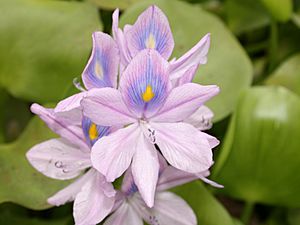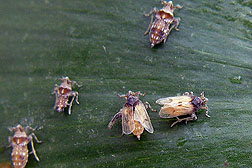Water hyacinth facts for kids
Quick facts for kids Water hyacinth |
|
|---|---|
 |
|
| Common water hyacinth (E. crassipes) | |
| Scientific classification | |
| Kingdom: | |
| (unranked): | |
| (unranked): | |
| (unranked): | |
| Order: | |
| Family: |
Pontederiaceae
|
| Genus: |
Eichhornia
|
Water hyacinths are amazing flowering plants that live in water. They belong to a group of plants called Eichhornia. There are seven different kinds, or species, of water hyacinths. These plants are part of the Pontederiaceae family, which is in the Commelinales order.
Water hyacinths are known for growing incredibly fast. They are originally from South America. However, they were brought to the USA in 1884.
Contents
What is a Water Hyacinth?
Water hyacinths are floating plants. They have round, shiny green leaves. These leaves often have air-filled stems that help the plant float. They also have beautiful purple or lavender flowers. These flowers grow on a tall spike.
The roots of the water hyacinth hang freely in the water. They are usually dark and feathery. These roots help the plant take in nutrients from the water.
Where Do They Live?
Water hyacinths love warm, sunny places. They grow best in freshwater areas. This includes lakes, ponds, rivers, and canals. They can form thick mats on the surface of the water.
Because they grow so fast, they can quickly cover large areas. This is especially true in tropical and subtropical regions. They prefer still or slow-moving water.
How Do They Grow So Fast?
Water hyacinths are champions at growing quickly. They can double their population in just a few weeks! They do this in two main ways.
Reproduction
First, they produce many seeds. These seeds can stay alive for a long time. They can sprout when conditions are right.
Second, they reproduce using "runners." These are like little stems that grow sideways. New plants sprout from these runners. This allows them to spread very rapidly across the water.
Why Can Water Hyacinths Be a Problem?
Even though they are pretty, water hyacinths can cause big problems. When they grow too much, they become an invasive species. This means they take over areas where they don't naturally belong.
They form thick mats on the water's surface. This blocks sunlight from reaching plants below. It also uses up a lot of oxygen in the water.
Impact on Water Life
When sunlight is blocked, underwater plants can't grow. Fish and other water animals need these plants for food and shelter. Less oxygen in the water also harms fish and other creatures. This can make it hard for them to survive.
Impact on People
Thick mats of water hyacinths can also block waterways. This makes it difficult for boats to pass. It can also clog irrigation systems. These systems are used to bring water to farms.
They can also make it harder to fish or swim. Sometimes, they even create places for mosquitoes to breed. This can spread diseases.
How Are Water Hyacinths Controlled?
People try different ways to control water hyacinths. It's important to manage them, especially in places where they cause problems.
Manual Removal
One way is to simply pull them out of the water. This is called manual removal. It works well for small areas. However, it's a lot of work for big areas.
Chemical Control
Sometimes, special chemicals called herbicides are used. These chemicals kill the plants. But using chemicals can sometimes harm other plants or animals. So, this method must be used carefully.
Biological Control
Another method is called biological control. This involves using natural enemies of the water hyacinth. For example, some insects eat water hyacinths.
In 2010, an insect called Megamelus scutellaris was released in some areas. This insect helps to control the water hyacinth population. It eats the plants, slowing their growth.
Interesting Facts
- Water hyacinths are sometimes used to clean polluted water. They can absorb harmful chemicals from the water.
- In some places, people use dried water hyacinths to make crafts. They can be woven into baskets or furniture.
- They are sometimes called "lilies of the Nile" because they look like lilies and can be found in the Nile River.
Images for kids
See also
 In Spanish: Jacinto de agua para niños
In Spanish: Jacinto de agua para niños











